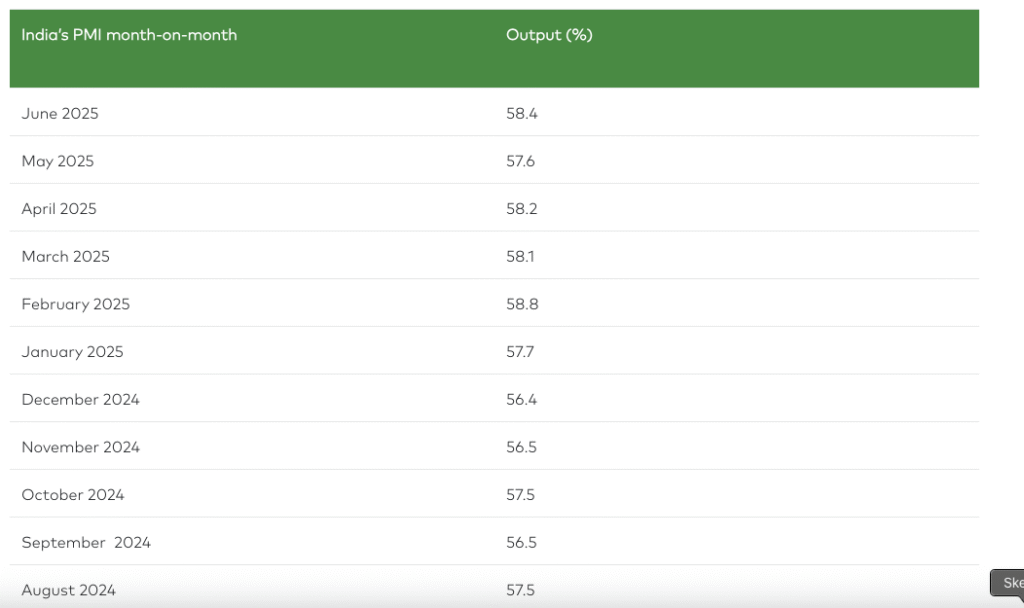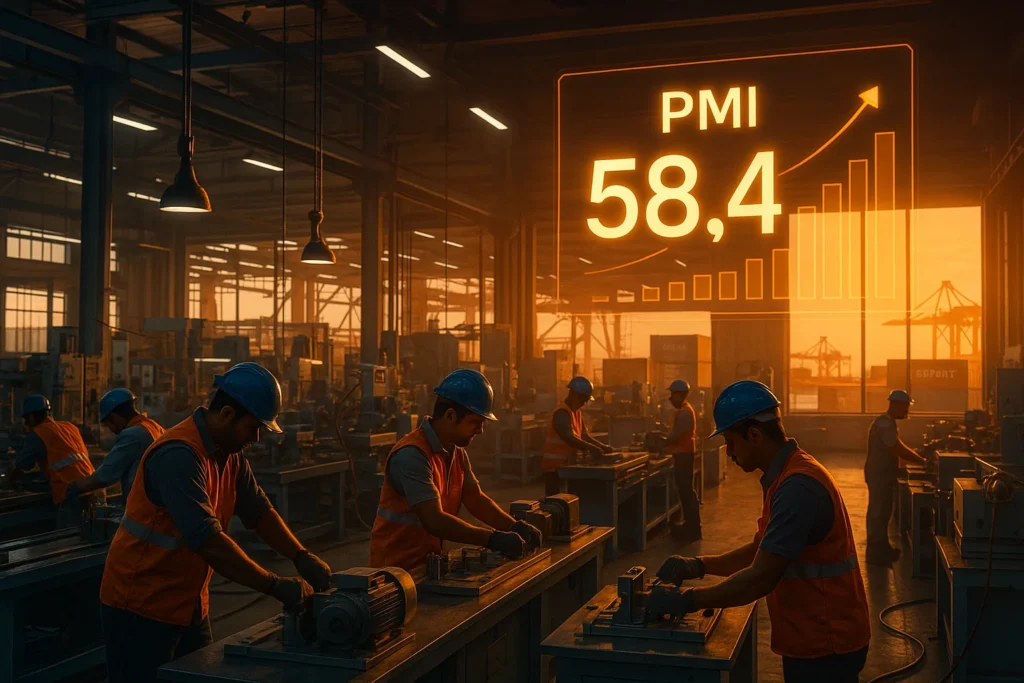Introduction: A Strong Signal for Manufacturing PMI Stocks
India’s manufacturing sector is showing signs of solid momentum, and investors are paying attention — especially those tracking manufacturing PMI stocks. In June 2025, the HSBC India Manufacturing Purchasing Managers’ Index (PMI) jumped to 58.4, its highest level in 14 months, signaling not just expansion, but acceleration.
A reading above 50 on the PMI indicates expansion in manufacturing activity. June’s figure of 58.4, up from 57.6 in May and well above the long-term average of 54.1, clearly suggests that Indian manufacturers are gaining confidence, increasing production, and witnessing rising demand both domestically and internationally.
But this isn’t just macro data — it’s a stock market signal. Historically, rising PMI numbers have been closely followed by gains in companies linked to core manufacturing, engineering, capital goods, and export-oriented businesses. In this context, identifying the right manufacturing PMI stocks can give investors an early lead on the next market trend.
In the following sections, we’ll break down:
- What’s driving this PMI surge
- Which sectors are leading it
- What it means for stock investors
- And most importantly, which stocks to watch now
Let’s decode the June PMI data and explore the best strategies to ride this manufacturing wave.
PMI Trends & Momentum — A Steady Climb
The headline India manufacturing PMI for June 2025 rose to 58.4, marking its highest level in 14 months. But what’s more important is the consistent month-on-month strength seen in recent data:

- January 2025 – 57.7
- February 2025 – 56.3
- March 2025 – 58.1
- April 2025 – 58.2
- May 2025 – 57.6
- June 2025 – 58.4
This upward trend shows broad-based recovery, despite temporary dips. The PMI index not only reflects current activity but also acts as a forward-looking indicator of economic momentum. A level consistently above 50 indicates expansion; levels closer to 60 point to strong, accelerating growth.
What’s Special About the June 2025 Print?
- It beat expectations.
- It’s well above the long-term average of 54.1.
- It marks the fastest pace of growth since April 2024.
- It comes despite geopolitical tensions in West Asia, showing domestic resilience.
For investors, this matters because manufacturing PMI stocks tend to move early, ahead of earnings, as PMI reflects both demand and production trends. Stocks in segments like engineering, capital goods, auto ancillaries, industrials, and exporters often rally first when PMI prints are strong.
Key Drivers Behind the PMI Surge
The sharp rise in the India manufacturing PMI in June 2025 didn’t happen in isolation — it was powered by strong internal and external demand, better supply chain efficiency, and record job creation.
Here’s what stood out:
1. Production Growth at a 14-Month High
June saw the fastest expansion in production volumes since April 2024. This was attributed to:
- Efficiency improvements in factory operations
- Stronger underlying demand
- Higher sales volumes
Importantly, this wasn’t just a seasonal bump. Survey feedback revealed a sustained increase in customer orders, giving manufacturers the confidence to scale up output.
2. Intermediate Goods Segment Led the Way
Interestingly, the acceleration came primarily from intermediate goods producers — the companies that make components or raw materials for other products. This suggests strong demand at the foundation level of the supply chain.
However:
- Consumer goods and capital goods segments showed signs of moderation.
- This indicates companies are still cautious about end-user demand, possibly due to inflation or global volatility.
For stock pickers, this could shift focus toward mid-cap industrials and input manufacturers rather than final product brands — a nuance that’s key for smart investing in manufacturing PMI stocks.
3. Export Orders at a 20-Year Peak
One of the biggest highlights of the June PMI report:
“Companies welcomed one of the fastest increases in external orders in the over 20 years of survey history.”
This shows India’s manufacturing is becoming more competitive globally — aided by:
- Supply chain realignment away from China
- Quality improvements in Indian manufacturing
- Favourable trade policies and bilateral ties
Expect export-focused firms — like auto parts exporters, industrial machinery suppliers, and electrical equipment makers — to benefit most.
4. Record Job Creation
For the first time in the survey’s recent history, manufacturers reported a record upturn in employment. More jobs indicate:
- Manufacturers are optimistic about demand
- They’re preparing to ramp up production capacity
This is a positive signal not just for growth, but also for wage-driven consumption, which can support retail and consumer-related stocks downstream.
5. Inventory Rebuilding and Input Buying
Manufacturers increased input buying at the strongest rate in 14 months, leading to a fresh build-up of:
- Raw material stocks
- Semi-finished goods
This is important because it shows:
- Confidence in future demand
- Smoothening of supply bottlenecks
- Stabilization of working capital cycles
These trends often precede capex decisions, which is bullish for capital goods and infra players — key segments within manufacturing PMI stocks.
Sector-wise Impact — Who’s Leading, Who’s Lagging?
The rise in the India manufacturing PMI in June 2025 is not uniform across all industry segments. While the overall headline number looks bullish, the real story lies beneath the surface — and that’s where savvy investors can spot opportunities.
Let’s break it down:
1. Intermediate Goods — The Backbone of Growth
This segment was the sole leader in driving the June PMI surge.
Intermediate goods are items like:
- Steel and metals
- Industrial components
- Chemicals and composites
- Electronic parts and cables
Growth here means companies are ramping up core production, preparing for higher demand across the supply chain. That signals strong earnings potential for:
- JSW Steel, Tata Steel, Ratnamani Metals
- Aarti Industries, SRF, Navin Fluorine
- Polycab, KEI Industries, Finolex Cables
These are top manufacturing PMI stocks to monitor, especially if the trend continues into Q2.
2. Capital Goods — A Pause Before the Push?
Interestingly, the capital goods segment (equipment used in production like machines, turbines, transformers) showed signs of moderation.
This doesn’t mean weakness — it could simply be:
- A breather after strong Q4 FY25 capex
- Firms waiting for more clarity on global orders
- Election-related project delays now getting cleared
Still, long-term investors should watch names like:
- Larsen & Toubro, Thermax, BHEL, GE T&D
- Cummins India, ABB, Siemens
A bounce-back here is likely in the coming months as government infra push resumes post-election.
3. Consumer Goods — Demand Still Building Up
The consumer goods segment (durables, appliances, packaged items) saw slower growth in June. Possible reasons:
- Demand fatigue after festive season highs
- Tight household budgets amid inflation
- Shift in rural vs urban consumption patterns
This segment is usually late-cycle — the pickup here will come after sustained industrial activity boosts income and employment.
Cautious optimism for:
- Havells India, Voltas, Crompton
- Marico, Godrej Consumer, Britannia
They’re not leading this rally, but they’ll follow if rural demand returns.
4. Export-Oriented Sectors — Strongest Tailwind
Export-heavy manufacturers are enjoying the fastest rise in foreign orders in 20+ years.
This includes:
- Auto components
- Precision engineering
- Industrial textiles
- Specialty chemicals
Top names to consider:
- Motherson Sumi, Sundram Fasteners, Bharat Forge
- AIA Engineering, Garware Technical Fibres
- Fine Organics, PI Industries
These stocks are direct beneficiaries of India’s global competitiveness, supported by China+1, free trade agreements, and better quality benchmarks.
How Global Tensions Are Testing Resilience
While the India manufacturing PMI in June 2025 delivered a bullish signal, it came against a backdrop of serious geopolitical headwinds that could’ve easily shaken confidence — but didn’t.
Flashpoint: Israel-Iran Escalation
The month saw a sharp escalation in West Asia tensions, with:
- Israel launching strikes on Iranian military and nuclear assets
- Iran retaliating with drones and missiles
- A global scramble at the G7 Summit and NATO meeting to contain fallout
These developments sparked fears of:
- Oil supply shocks
- Supply chain disruptions
- Cybersecurity threats
- Trade route closures (especially near the Strait of Hormuz)
But India’s Manufacturing Held Firm
Despite these risks, Indian manufacturers:
- Increased production
- Expanded inventories
- Reported rising export orders
This shows that India is becoming structurally resilient, benefiting from:
- Diversified trade links (less West Asia dependence)
- Stable domestic demand
- China+1 global shift in sourcing
- Improved energy security and logistics
Market Volatility vs Business Stability
Although markets saw minor volatility due to war headlines, business activity remained strong — a key point for investors.
What this means for manufacturing PMI stocks:
- Short-term geopolitical risks may shake prices
- But operational performance and order flows are intact
- Stocks with global exposure may re-rate higher due to India’s perceived stability advantage
Look at stocks like:
- GE T&D, Thermax, L&T for infra exports
- Divgi TorqTransfer, Schaeffler India for high-tech auto exports
- Bharat Electronics, Data Patterns (defense + tech angle)
These companies could attract premium valuations as global clients seek risk diversification in their supply chains.
GDP Rebound & Macro Tailwind for PMI Stocks
India’s strong manufacturing PMI print doesn’t stand alone — it’s supported by a broader macroeconomic recovery. June 2025’s data aligns with a clear bounce-back in GDP growth, which reinforces the bullish case for manufacturing PMI stocks.
India’s Growth is Picking Up Pace Again
According to provisional data from the Ministry of Statistics, India’s GDP grew by 6.5% in FY25, driven by a robust 7.4% expansion in the January–March quarter.
- In contrast, the previous year’s Q4 growth was even higher at 7.8%, but that was off a lower base.
- Meanwhile, full-year FY24 growth was a stronger 9.2%, boosted by post-pandemic recovery.
- Still, the 6.5% growth in FY25 reflects a more balanced and sustainable pace, led by real output improvements — not just base effects.
Manufacturing’s Share is Rising Again
Interestingly, manufacturing GVA grew by 4.5% in FY25, reaching ₹29.54 trillion.
While that’s slower than FY24’s 12.3% growth, it still shows resilience despite a higher base.
Moreover:
- Construction, mining, and services also grew, showing broad economic participation.
- Agriculture added support through stable yields and rural demand.
As a result, manufacturing is no longer lagging — it’s regaining its role as a core engine of GDP, particularly in early-cycle recoveries.
PMI Data Supports the Macro Turnaround
When we connect this to the India manufacturing PMI for June 2025, the picture becomes clearer:
- Rising orders, job creation, and input buying point to further output growth
- That growth will reflect in higher industrial production numbers, and eventually in earnings of listed companies
Therefore, smart investors tracking macro data can start positioning in manufacturing PMI stocks ahead of broader index moves.
Stocks That Benefit from Macro + PMI Combo
These companies operate in sectors where macro and micro tailwinds overlap:
- L&T, Siemens, Thermax – Capital goods + infra growth
- Polycab, KEI Industries – Electrical infra + rural demand
- Bharat Forge, Motherson Sumi – Export auto parts + global rebound
- BHEL, GE T&D – Power, transmission, and government capex plays
In summary, as GDP climbs and PMI surges, India’s manufacturing ecosystem is back on the growth track. This creates a double boost for companies at the heart of production, making manufacturing PMI stocks a powerful theme for FY26.
Stocks to Watch — Riding the Manufacturing Momentum
| Category | Stocks to Watch | Why They Matter |
|---|---|---|
| Capital Goods & Infrastructure | – Larsen & Toubro (L&T) – Siemens – Thermax – ABB India – GE T&D | Backed by government + private capex; strong project pipelines and industrial automation demand |
| Intermediate & Core Manufacturing | – JSW Steel – Ratnamani Metals – Polycab – KEI Industries – Finolex Cables – SRF – Aarti Industries – Navin Fluorine | Early-cycle leaders; rising input demand and production volumes drive growth |
| Auto Ancillaries & Export Engineering | – Motherson Sumi – Bharat Forge – Sundram Fasteners – AIA Engineering – Carborundum Universal – Divgi TorqTransfer – Schaeffler India | Export orders rising sharply; beneficiaries of global shift away from China |
| Power & Electrical Equipment | – BHEL – CG Power – TD Power – V-Guard – Havells India – Voltas – Crompton Greaves | Demand rise from infra, industrial capex, and energy modernization |
| High Potential Smallcaps | – Shakti Pumps – Garware Technical Fibres – TD Power Systems – Precision Camshafts | Niche players with high growth visibility; exposed to exports and specialized markets |
Conclusion: Manufacturing Momentum Is Real — Don’t Miss the Signal
The sharp rise in the India manufacturing PMI to 58.4 in June 2025 is more than just a headline — it’s a clear signal of economic resilience and sectoral strength. Backed by a rebound in GDP, surging export orders, and record job creation, the manufacturing sector has firmly re-established itself as a growth engine for the Indian economy.
What makes this PMI surge significant is its breadth and depth:
- Intermediate goods are in high demand,
- Capital goods and infra are poised for a pickup,
- And export-oriented players are riding a once-in-two-decade wave of global orders.
For investors, this is not just macro data — it’s a stock-picking roadmap.
From large-cap industrial giants to high-growth smallcaps, manufacturing PMI stocks offer opportunities across market caps and timelines.
In the short term, volatility from global tensions may create dips.
But over the medium to long term, India’s structural growth story — fueled by Make in India, supply chain shifts, and digital-led efficiencies — is just getting started.
👉 The strategy now? Stay selective, focus on quality manufacturers, track order books, and watch how demand trends translate into earnings upgrades.
This is India’s manufacturing decade. The June PMI is just the latest proof.
Related Articles
How a Tea Seller Used the Power of Compound Interest to Build ₹45 Lakh
Rare Earth Magnet Manufacturing Stocks: Catch These Before India’s ₹1,000 Cr Push Lifts Off






